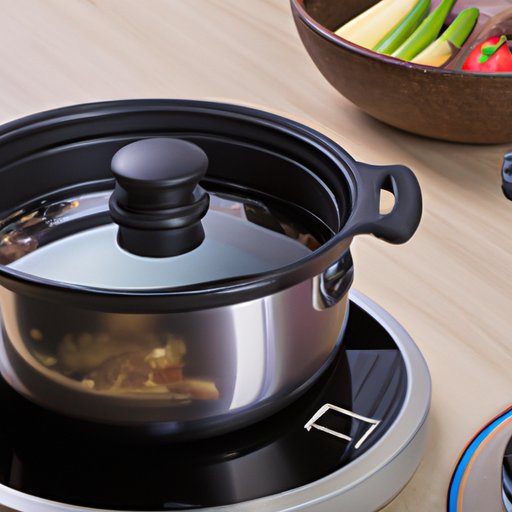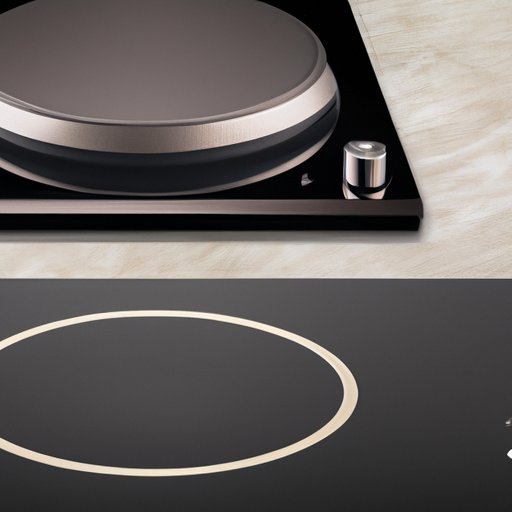Introduction
Induction cooking is a relatively new way of cooking that is becoming increasingly popular. It uses electromagnetic energy to heat up food quickly and efficiently. In this article, we will explore how an induction cooktop works, as well as the pros and cons of using one. We will also compare different types of cooktops and provide some tips for choosing the right one for your needs.
Step-by-Step Guide to Using an Induction Cooktop
Using an induction cooktop is fairly simple, but there are a few steps you should follow to ensure that it works properly. Here is a step-by-step guide to using an induction cooktop:
Preparing your cooktop for use
The first step is to make sure that the cooktop is plugged in and turned on. Once the cooktop is powered up, you can begin setting the temperature. Make sure that the cooktop is level and stable before turning it on.
Setting the temperature and timer
Once the cooktop is powered up, you can set the desired temperature and timer. Most induction cooktops come with a digital display that allows you to precisely control the temperature and timer. Some models also have knobs or buttons that allow you to set the temperature and timer manually.
Placing the cookware on the cooktop
Once the temperature is set, it’s time to place the cookware on the cooktop. Make sure that the cookware is compatible with the cooktop and is made of a material that is suitable for induction cooking (such as cast iron or stainless steel). If the cookware is not compatible, it won’t be able to generate heat and the cooktop won’t work.
Utilizing additional features of the cooktop
Most induction cooktops come with additional features such as pre-set cooking programs, power levels, and even timers. These features can help you get the most out of your cooktop and ensure that your meals are cooked perfectly every time.

Pros and Cons of Induction Cooking
Induction cooking has many advantages over traditional methods of cooking, but there are also some drawbacks. Here are some of the pros and cons of using an induction cooktop:
Benefits of induction cooking
- Faster cooking times: Induction cooktops heat up quickly and evenly, which means that meals can be cooked in less time.
- More precise temperature control: With an induction cooktop, you can precisely control the temperature and timer to ensure that your meals are cooked exactly how you want them.
- Energy efficiency: Induction cooking is very efficient, meaning that less energy is wasted during the cooking process.
- Safety: Induction cooktops do not generate heat, so they are much safer than traditional gas or electric cooktops.
Drawbacks of induction cooking
- Expense: Induction cooktops are more expensive than traditional gas or electric cooktops.
- Compatibility: Not all cookware is compatible with induction cooktops, so you may need to invest in new cookware if you switch to induction cooking.
- Limited features: Induction cooktops generally have fewer features than traditional gas or electric cooktops.
What You Need to Know Before Buying an Induction Cooktop
When shopping for an induction cooktop, there are a few factors to consider. Here are some things to keep in mind when comparing different models:
Comparing different models
There are many different models of induction cooktops available, so it’s important to compare different models to find the one that best suits your needs. Consider the size, features, price, and warranty of each model before making a decision.
Factors to consider when choosing a cooktop
- Size: Consider the size of the cooktop and how much space it will take up in your kitchen.
- Features: Look for features such as pre-set cooking programs, power levels, and timers.
- Price: Compare prices to find the best value for your money.
- Warranty: Check the warranty of the cooktop to make sure that it is covered in case of damage or malfunction.
Comparing Electric, Gas and Induction Cooking
When it comes to cooking, there are three main types of cooktops: electric, gas, and induction. Each type of cooktop has its own advantages and disadvantages, so it’s important to consider all of the factors before deciding which one is best for you.
Advantages and disadvantages of each type of cooking
- Electric: Electric cooktops are easy to use and require minimal maintenance. They are also relatively inexpensive. However, they can take longer to heat up and are not as energy efficient as other types of cooktops.
- Gas: Gas cooktops are fast and efficient. They are also relatively inexpensive. However, they require more maintenance and can be dangerous if not used correctly.
- Induction: Induction cooktops are fast, efficient, and safe. They are also more energy efficient than other types of cooktops. However, they are more expensive and not all cookware is compatible with them.
Cost comparisons
When it comes to cost, electric and gas cooktops tend to be the most affordable options. Induction cooktops are more expensive, but they are also more efficient and safer. Ultimately, the cost of the cooktop depends on the features and size that you choose.
Conclusion
Induction cooktops are becoming increasingly popular due to their fast cooking times and precise temperature control. They are more energy efficient than traditional electric or gas cooktops, but they are also more expensive. When choosing a cooktop, it’s important to consider the size, features, price, and warranty of different models before making a decision. Comparing electric, gas and induction cooking can help you determine which type of cooktop is best for your needs.
(Note: Is this article not meeting your expectations? Do you have knowledge or insights to share? Unlock new opportunities and expand your reach by joining our authors team. Click Registration to join us and share your expertise with our readers.)
